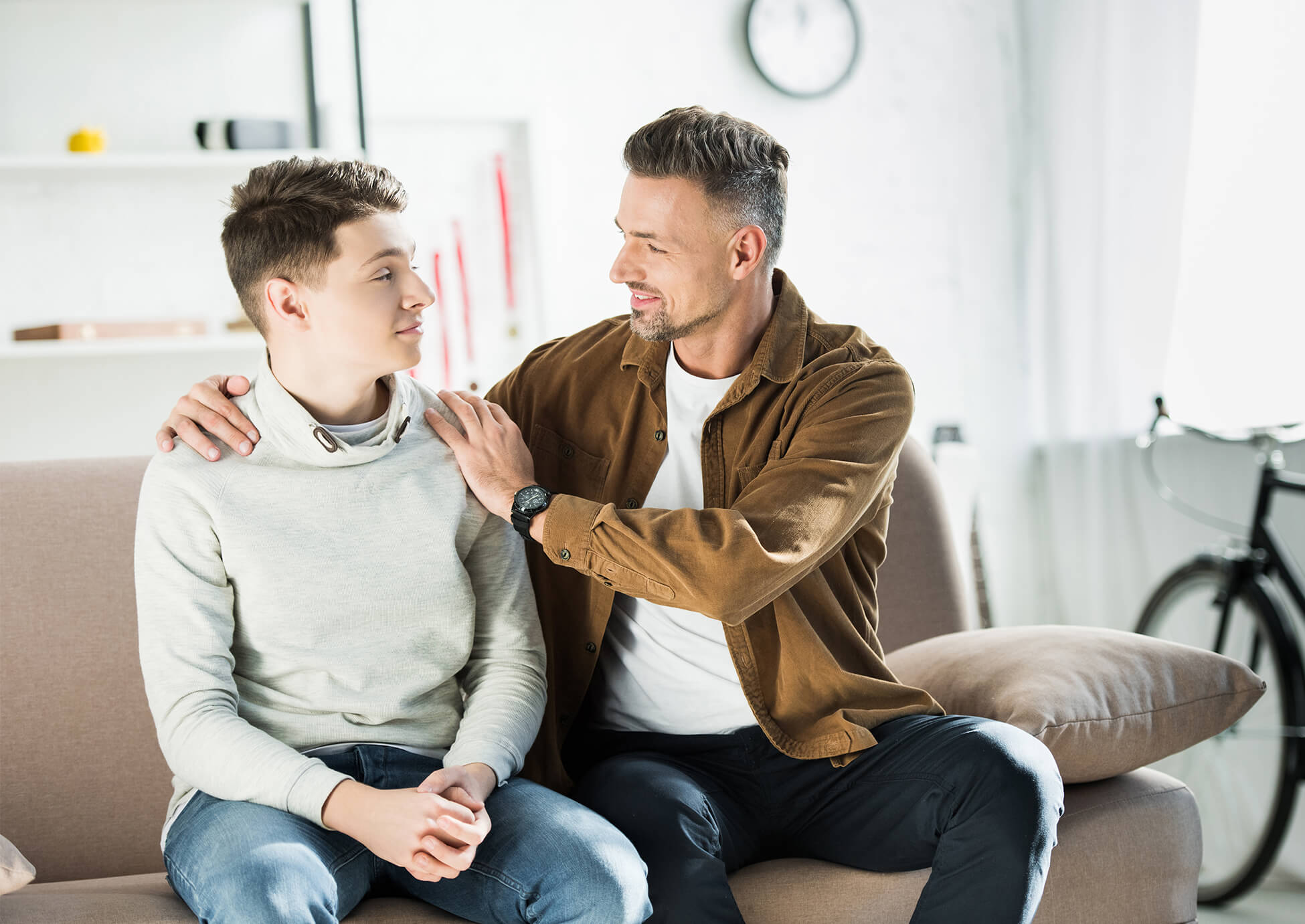Coming Out
Information for parents of LGBTQ+ teens to support their children
Coming Out is Different for Everyone.
“Coming out” is a lifelong journey of understanding, acknowledging, and sharing one’s gender identity and/or sexual orientation with others.
It may be quick and easy for some, or longer and more difficult for others.
It is important for parents of lesbian, gay, bisexual, and transgender (LGBTQ+) teens to remember each child is unique and will have their own experiences and feelings along the way.
Common Feelings for LGBTQ+ Youth
As parents and caregivers create safe environments for their children to open up about their sexual or gender identity, below are some common feelings they may express and some guidance on how parents can handle these conversations.

“I feel different from other kids . . .”
Feelings of being different emerge throughout childhood, although it may not be clear to the child what the feelings means. Children may begin exploring gender and relationships before kindergarten, so “coming out” and sharing these feelings of being different with others may happen at any time. For many kids, gender identity becomes clear around puberty as they develop gender characteristics and stronger romantic attractions. However, many LGBTQ+ teens have said, in retrospect, that they began to sense something different about themselves early in life, and for gender diverse youth, sometimes as far back as preschool.
It is common for LGBTQ+ teens to feel scared or nervous during this stage. Some can start to feel isolated from their peers, especially if they feel that they don’t fit in or are given a hard time for being different. Just remember that children who feel loved and accepted for who they are have a much easier time.
Parents and Families Can:
- Play an important role advocating for safe spaces where their child can explore interests without judgment or stereotypes.
- Support diverse friendships and social involvement without focusing on expectations around gender.
- Provide exposure to people working and enjoying activities outside of conventional gender expectations.
- Engage in conversations and check regularly with your children about their interests, friend groups, romantic attractions, and any bullying or teasing that may be taking place.
“I think I might be gay (or lesbian, bi, or trans), but I’m not sure, and I don’t know how I feel about that…”
Beyond just feeling different, young people begin to wonder if they might be “gay” (or lesbian, bi or trans) or some other label they may prefer. Many teens have mixed feelings when they first try on a new way of identifying. It can be a mix of excitement, relief, and worry.
Many children may try to suppress these feelings to meet societal expectations, to fit in, or even to avoid upsetting their parents or families. In some cases, teens might be overwhelmed by all these feelings, which increases the risk for depression, anxiety, and other mental health issues. For example, they may isolate themselves from others for fear of being exposed, or “outed.” Some teens may feel very alone, especially if they live in a community that doesn’t have an active LGBTQ+ youth support system. Having a supportive and helpful environment at home and good relationships with friends and will help teens to manage their feelings and deal with any discrimination they may face.
“I accept that I’m gay, but what will my family and friends say?”
Teens may accept that they are LGBTQ+ but not yet ready to start sharing this information with anyone yet. Some will feel comfortable being open about their identity, while other teens may not tell anyone for a long time. Teens may look for clues on how you feel about their gender identity and sexual orientation. Speaking positively about LGBTQ+ celebrities or current events you will let them know you are supportive of their identity.
Society has become more open and accepting of LGBTQ+ individuals, and young people are beginning to come out at earlier ages than they did a generation ago. Children may first come out to online communities or peers they perceive as safe and accepting before telling their family.
It is important for parents and children to realize that acceptance is a process that involves the entire family. Just as it takes time and support for LGBTQ+ children to understand and accept their identity, this is also true for parents.

“I’ve told most of my family and friends that I’m gay (or lesbian, bi, or trans).”
Teens feel secure enough in who they are and share that information with loved ones. It takes courage and strength for a young person to share who they are inside, especially for teens who are unsure of how their families will respond. They may be afraid of disappointing or angering their families, or in some instances may fear being physically harmed or thrown out of their homes. Again, parents usually need time to deal with the news. While it may take them days, weeks or many months to come to terms with their child’s sexuality or gender identity, it is important for parents to show love and support for their child, even if they don’t fully understand everything.
Coming out to others can be a liberating experience, especially for those teens who are embraced by their communities and families. LGBTQ+ teens may feel free to speak openly about their feelings and possibly romantic relationships for the first time. For transgender and gender diverse teens, they may finally feel free to begin expressing themselves genuinely as the gender they feel inside.
Parents and Families Can:
- When your child discloses his or her identity to you, respond in an affirming, supportive way. Understand that although gender identity is not able to be changed, it often is revealed over time as people discover more about themselves.
- Accept and love your child as they are. Try to understand what they are feeling and experiencing. Even if there are disagreements, they will need your support and validation to develop into healthy teens and adults.
- Stand up for your child when he or she is mistreated. Do not minimize the social pressure or bullying your child may be facing.
- Make it clear that slurs or jokes based on gender, gender identity, or sexual orientation are not tolerated. Express your disapproval of these types of jokes or slurs when you encounter them in the community or media.
- Be on the look out for danger signs that may indicate a need for mental health support such as anxiety, insecurity, depression, low self-esteem, and any emotional problems in your child and others who may not have a source of support otherwise.
- Connect your child with LGBTQ+ organizations, resources, and events. It is important for them to know they are not alone.
- Celebrate diversity in all forms. Provide access to a variety of books, movies, and materials—including those that positively represent gender diverse individuals. Point out LGBTQ+ celebrities and role models who stand up for the LGBTQ+ community, and people in general who demonstrate bravery in the face of social stigma.
- Support your child’s self-expression. Engage in conversations with them around their choices of clothing, jewelry, hairstyle, friends, and room decorations.
- Reach out for education, resources, and support if you feel the need to deepen your own understanding of LGBTQ+ youth experiences.

It’s Important to Remember:
Even if you are having trouble understanding your child’s identity or feelings, not withdrawing from your role as a parent is probably one of the most important ways to help a child continue to feel a sense of being cared for and accepted. Feeling loved has been shown to be critical to overall health and development of all children regardless of gender or sexual orientation. Many parents do need their own supports to help them understand and cope with their own difficult emotions and concerns during a child’s “coming out.”
References & Sources
By being here, you’re impacting generations.
American Society for the Positive Care of Children is dedicated to preventing child maltreatment and raising awareness of the lifelong impacts of adverse childhood experiences by providing parents with the skills, tools, and educational resources that build their confidence and capacity as caregivers and create more positive childhood experiences. We’re able to continue providing resources like these free of charge to nearly 1,000,000 families who rely on us annually thanks to the generosity of our supporters.
Take action to reduce Adverse Childhood Experiences for the Next Generation Today.

By being here, you’re impacting generations.
American Society for the Positive Care of Children is dedicated to preventing child maltreatment and raising awareness of the lifelong impacts of adverse childhood experiences by providing parents with the skills, tools, and educational resources that build their confidence and capacity as caregivers and create more positive childhood experiences. We’re able to continue providing resources like these free of charge to nearly 1,000,000 families who rely on us annually thanks to the generosity of our supporters.
Take action to reduce Adverse Childhood Experiences for the Next Generation Today.
